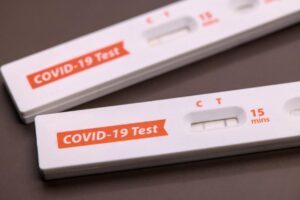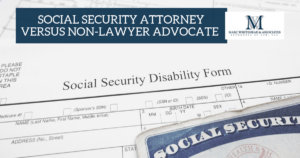
1. Why This Topic Matters
COVID-19 may have slipped from the headlines, but its lasting after-effects keep flooding the desks of claimant’s lawyers and adjudicators. A February 2025 Kaiser Family Foundation survey estimates nearly 18 million U.S. adults still report “post-acute sequelae of SARS-CoV-2 infection” (PASC, a/k/a Long COVID)—and a non-trivial slice are now unable to keep a job. Meanwhile, Social Security has issued no stand-alone “Long COVID” Listing. That leaves representatives to map a kaleidoscope of symptoms onto the familiar—but often ill-fitting—Listing framework.
This article gives you a step-by-step blueprint to:
- Translate Long COVID science into SSA’s five-step sequential evaluation.
- Pin each major residual to the correct Listing (respiratory, cardiac, neuro, mental, immune, renal).
- Build objective evidence that survives skeptical DDS reviewers.
- Counsel potential clients on what turns a lingering infection into a compensable disability.
Whether you are triaging a new file or preparing for an ALJ hearing, the tools below will keep you out of evidentiary dead-ends and, more importantly, will help disabled Long-COVID survivors secure the benefits they need.
For a free legal consultation, call (800) 562-9830
2. A Quick Refresher: SSA’s Five-Step Ladder
| Step | Core Question | Long-COVID Twist |
|---|---|---|
| 1. SGA | Earning ≥ $1,550/month (2025) since onset? | Many PASC clients attempt intermittent, part-time work. Flag months over the SGA line early. |
| 2. Severity & Duration | Medically determinable impairment (MDI) that limits basic work activities for ≥ 12 months? | SSA accepts PASC as an MDI only when documented by: (a) positive PCR/antigen test or diagnosis by a licensed medical source; and (b) objective findings (e.g., PFTs, imaging, neuro-cognitive scores). (“Long COVID” alone in the chief-complaint box is not enough.) |
| 3. Listings | Meets/equals a Listing? | There is no “Listing 3.15 Long COVID.” You must slot the residuals into 3.00, 4.00, 6.00, 11.00, 12.00, or 14.00 as appropriate. |
| 4. Past Relevant Work | Still capable of claimant’s own past jobs? | PASC often erodes stamina, pace, and concentration; document failed return-to-work attempts. |
| 5. Other Work | Adjust to other work in the national economy? | Fatigue‐related off-task time or post-exertional symptom exacerbation can wipe out even sedentary job bases if empirically documented. |
3. Mapping Long COVID to the Current Listings
3.1 Respiratory Dominant Cases – Listings 3.02, 3.03, 3.09, 3.14
Most PASC clients still complain first about dyspnea, cough, or exercise intolerance. The entire 3.00 Series was overhauled effective 4-2-2021; every rule you need is therefore current.
- 3.02 Chronic Respiratory Disorders – use when CT scans show interstitial “ground-glass” or fibrotic change, or spirometry shows FEV₁/FVC deficits. DLCO ≤ 40 % or resting SpO₂ ≤ 89 % may qualify.
- 3.03 Asthma – for post-viral airway hyper-reactivity; prove ≥ two ER visits or inpatient stays 30 days apart within 12 months despite treatment.
- 3.09 Chronic Pulmonary Hypertension – pulmonary vascular remodeling after COVID myocarditis can elevate mean PAP; right-heart catheter or equivalent imaging is essential.
- 3.14 Respiratory Failure – claimant who required intubation/ECMO and has at least one more episode (or ongoing need for daytime ventilatory support) can meet this listing outright.
Practice Tip: SSA’s Emergency Message EM-21032 REV 2 directs DDS adjudicators to treat PASC respiratory findings exactly the same as COPD, ILD, or pre-existing pulmonary hypertension—they do not get looser criteria because the cause is viral. You must supply the hard numbers.
3.2 Cardiac Sequelae – Listings 4.02, 4.04, 4.05, 4.09
Myocarditis, dysautonomia, and postural orthostatic tachycardia syndrome (POTS) have emerged as common Long-COVID complications.
- 4.02 Chronic Heart Failure – document reduced LVEF (≤ 30 %) or exercise ejection fraction limitations.
- 4.04 Ischemic Heart Disease – some PASC patients develop microvascular angina; abnormal stress-test or angiography proof needed.
- 4.05 Recurrent Arrhythmias – sustained A-fib/A-flutter unresponsive to meds or ablation.
- 4.09 Heart Transplant – a handful of severe myocarditis cases trigger this automatic listing.
3.3 Neurological & Cognitive Issues – Listings 11.02, 11.18, 12.02
Brain-fog is the most litigated symptom right now.
- 11.18 Traumatic (or other) Brain Injury applies to post-hypoxic encephalopathy from ICU stays.
- 11.02 Epilepsy is your back-door listing when claimant develops post-infection seizure-like spells.
- 12.02 Neurocognitive Disorder is often the best fit; you’ll need a formal neuro-psych battery showing ≥ 2 SD decline in at least one domain plus marked/extreme functional deficits.
3.4 Auto-Immune / Inflammatory – Listings 14.09, 14.10
Some Long-COVID patients present with new-onset inflammatory arthritis or connective-tissue disease–like syndromes. Rheumatology notes, elevated CRP/ESR, and positive ANA bolsters these listings.
4. Proving the Case: Evidence That Moves the Needle
- Pulmonary Function Tests – Spirometry (FEV₁, FVC), DLCO, 6-Minute Walk SpO₂ logs.
- High-Resolution CT – ground-glass opacities or fibrosis satisfy “chronic” requirement.
- Cardiac Work-Up – Echocardiogram, cardiac MRI, Holter, stress echocardiography.
- Neuro-Psychology Battery – WAIS-IV, Trail-Making, Rey Auditory; compare premorbid IQ where possible.
- Tilt-Table or Autonomic Reflex – for POTS orthostatic intolerance.
- Hospital Records – intubation dates, ECMO, ICU delirium notes; they prove severity and arguably “listing-level” episodes (e.g., 3.14).
- Pharmacy Fills – longitudinal medication compliance; combats “non-severe” arguments.
- Third-Party Statements – family log of post-exertional symptom exacerbation; employer write-ups for pace deficits.
Remember: the duration rule still governs. A spectacularly awful 10-week episode is non-compensable unless residuals persist (or are expected to persist) at least 12 months.
5. What if No Listing Fits? Functional Wins at Steps 4 & 5
Not every PASC claimant hits an objective threshold. You can still win by showing that Residual Functional Capacity (RFC) rules out all competitive work.
- Document Off-Task Time – Post-exertional malaise often forces unscheduled breaks; anything ≥ 15 % of the day typically eliminates all jobs per VE testimony.
- Absenteeism – Long COVID flares causing two absences per month can be fatal to job numbers.
- Cognitive/Pace Limits – Processing-speed scores ≤ 5 th percentile justify a work-pace accommodation that most VEs admit erodes the unskilled occupational base.
- Orthostatic Symptoms – Need for head-elevated or recumbent rest every hour can disqualify sedentary work.
6. Practical Intake & Screening Tips
- Confirm the Virus – SSA still wants an initial positive PCR/antigen or serology. Clients diagnosed clinically should be sent for antibody testing right away.
- Triage for Chronicity – Ask, “Have your symptoms kept you from full-time work at least nine of the last twelve months?” Anything shorter may die on duration.
- Green Lights
- Two PFTs six months apart, both showing FEV₁ ≤ 65 %.
- Cardiac MRI with LVEF ≤ 35 %.
- Neuro-psych < 2 SD plus employer write-ups.
- Red Flags
- No objective testing; all notes “subjective fatigue.”
- Continued earnings near SGA; only length-of-day reduction.
- Substance abuse confounding symptoms.
7. Building the File Without Blowing the Budget
- Pulmonary labs are relatively cheap ($250–$350); order early.
- Neuro-psych batteries cost $1,200+—reserve for cases clearly headed to 12.02.
- Cardiac Holter monitors are billable to insurance; coordinate with PCP.
- Use free metrics – PHQ-9, PCL-5, 6MWT-SpO₂ can be captured in-clinic without cost.
- Front-load Forms – Submit SSA-3373 (ADLs) and third-party SSA-3380 with explicit references to Listings’ functional language (“I need reminders,” “I can’t keep pace for more than 10 minutes”).
8. Hearing-Room Strategy
- Direct of Claimant – Let them walk through a “good day” and “bad day”; ALJs need to feel post-exertional crashes.
- Medical Expert – Pin them on listing criteria they overlooked (“Doctor, DLCO 39 % meets 3.02C, correct?”).
- Vocational Hypotheticals
- Off-task ≥ 20 % / two absences mo.—VE will concede no jobs.
- Sedentary but must elevate legs to reduce tachycardia.
- Processing-speed 1 st percentile, needing ≤ 80 % of average pace.
- Cognitive lapses requiring rereading instructions every 10 minutes (erodes clerical jobs).
- Fallback Paragraph C (mental listings) – 24-month longitudinal record + marginal adaptation from flare triggers C(2).
9. Counseling Potential Clients
- Stay in Treatment – Gaps kill credibility; even tele-rehab counts.
- Keep a Symptom Diary – Date, activity, crash duration. Judges respect data-driven self-reports.
- Request Objective Testing Early – Lung function, tilt-table, neuro-psych. The longer you wait, the harder retroactive proof becomes.
- Expect Denials – Mental-only and Long-COVID claims have initial allowance rates in the low 20 % range; hearings are where they win.
10. Final Take-Aways
- Long COVID is not its own Listing; think “Which body system is worst today?”
- Use the 3.00 Series for respiratory sequelae; every criterion dates to the April 2021 overhaul and sunsets 2026.
- Objective numbers—PFTs, EFs, DLCOs, cognitive SDs—carry far more weight than “fatigue” narratives alone.
- When listings fall short, RFC evidence of off-task time, absences, and pace still wins.
- Follow SSA’s EM-21032 guidance word-for-word in briefs; adjudicators know it and expect you to cite it.
With a disciplined, evidence-first approach, Long-COVID claims move from “novel and uncertain” to “thoroughly winnable”—providing life-saving benefits to clients and sustainable fees to the lawyers who master the rules.




